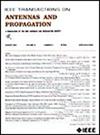A Compact Ultrawideband Antenna System With Stable Broadside Radiation Patterns for Brain–Machine Interface Applications
IF 4.6
1区 计算机科学
Q1 ENGINEERING, ELECTRICAL & ELECTRONIC
引用次数: 0
Abstract
In this study, we have developed a compact and ultrathin wideband antenna system with stable broadside radiation patterns for brain-machine interface applications. The antenna system operates in the ultrawideband (UWB) frequency range and employs a deionized (DI) water-infilled superstrate to achieve efficient radiation in the broadside direction. The antenna was constructed using a thin Taconic TRF-43 substrate, which has a relative permittivity (求助全文
约1分钟内获得全文
求助全文
来源期刊
CiteScore
10.40
自引率
28.10%
发文量
968
审稿时长
4.7 months
期刊介绍:
IEEE Transactions on Antennas and Propagation includes theoretical and experimental advances in antennas, including design and development, and in the propagation of electromagnetic waves, including scattering, diffraction, and interaction with continuous media; and applications pertaining to antennas and propagation, such as remote sensing, applied optics, and millimeter and submillimeter wave techniques

 求助内容:
求助内容: 应助结果提醒方式:
应助结果提醒方式:


